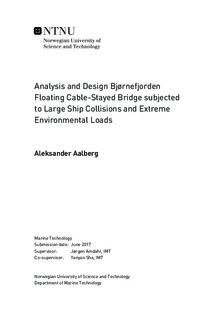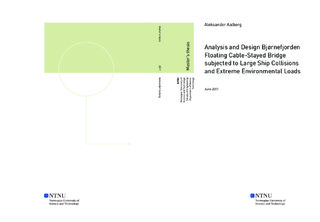| dc.description.abstract | The purpose of this master thesis is to analyse one of the proposed bridge design for the Bjørnafjorden crossing, exposed to extreme environmental loads and large ship impacts. This is a floating cable-stayed bridge with a total length of nearly 5 kilometers, where the floating part is supported by 19 pontoons. The main focus was put on studying the response caused by wind and waves, while ship collision was limited to analysing the global integrity of the bridge.
Wave induced response was investigated for two different wave directions, which had the largest 100-year significant wave height. Both linear wave loads and slowly-varying drift forces was accounted for and introduced as time-varying load histories, established from the corresponding transfer functions. Due to the large length of the bridge it could be relevant to study how the bridge behaviour is affected by the correlation between the wave loads acting on the pontoons. This was done using two different approaches, one with fully uncorrelated heave force and a second correlation established from the position of each pontoon. The two wave directions and correlations was further analysed in order to find the worst condition, which should be used to establish the characteristic response. For the worst sea state 90 1-hour simulations was conducted in order to approximate the characteristic wave response from 30 3-hour simulations. This was done by fitting 30 maximum values to a Gumbel distribution and using the 90\% fractile as the characteristic response. The effect from wind was studied together with fully correlated waves from west, where the total wind field consisted of both a mean and turbulent component established using WindSim.
Ship collision was simulated by use of spring elements with assigned vessel strength properties and applied at two different impact locations, where both pontoon and bridge girder collision was investigated. The vessel strength was modelled using a force-deformation curve for the bulb and forecastle, assuming strength design of the bridge. Different impact energies was studied in order to analyse the effect of impact speed.
The analysis with environmental loads showed that linear waves induces large moments in the bridge girder, while slowly-varying drift forces and wind are important for horizontal motions. Waves from north-west in combination with the correlation obtained by accounting for the different pontoon positions proved to give the largest response in the bridge girder. This condition was therefore used to establish the characteristic wave response, which showed that the design capacity with regard to yielding was exceed for one of the box girders and column. According to these results the strength against bending must be increased.
The ship collisions gave rise to large utilizations in the bridge girder with values close to fully utilized, for the largest impact energies. For pontoon collision this resulted in permanent displacements of the bridge girder, due to plastic rotations in the cross beams. This may not necessarily be critical for the design as long as the permanent displacement do not impair the global integrity. Further, as long as the bridge is able to maintain the stress level in the fully utilized parts the current design appears to have sufficient resistance against ship impact. On the other hand if collision with the bridge girder results in extensive damage to one of the box girders, it may be critical in connection with surviving 100-year environmental loads.
On a late stage of the master thesis it was discovered that the cross sectional properties of the cross beams about the local y- and z-axis appears to be switched. This is something that may affect the result both with regard to environmental loads and ship collision. It is therefor recommended to study the effect of this discrepancy further. | |

